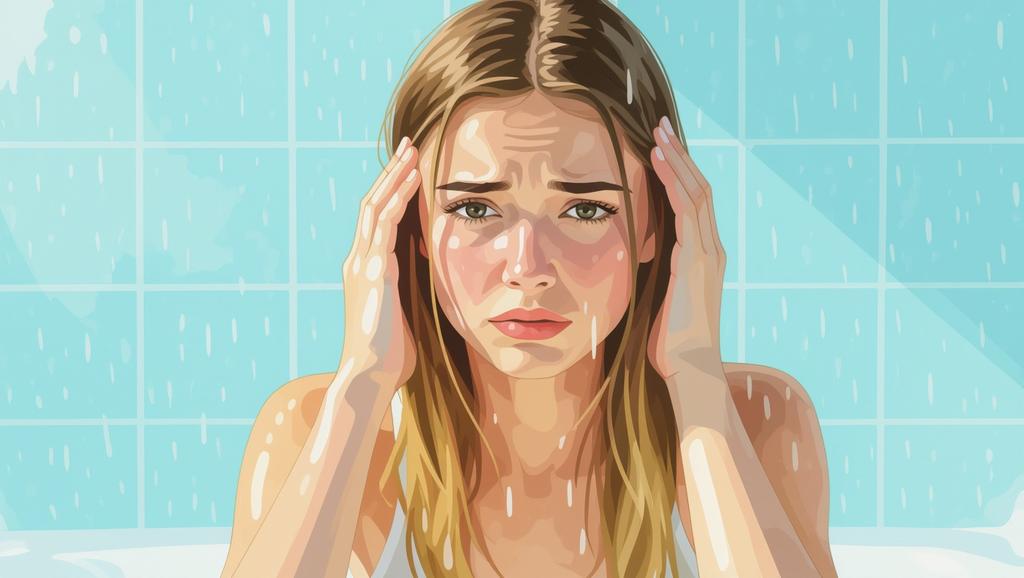Understanding oily hair
What causes oily hair?
Oily hair can be a real drag, especially when it seems like you just can’t get rid of that greasy feeling. But don’t worry, you’re not alone! Oily hair is caused by the natural oils, or sebum, produced by your scalp’s sebaceous glands. These oils are meant to keep your hair and scalp hydrated, but sometimes they can go a bit overboard. Factors like genetics, hormonal changes, stress, and even your diet can play a role in how much oil your scalp produces. If you find yourself constantly battling with oily hair, it might be time to take a closer look at these factors.
For instance, if you’ve been noticing your hair getting greasier lately, it could be due to hormonal fluctuations. Hormones like androgens can increase sebum production, which is why you might see more oil during certain times of the month or life stages like puberty or pregnancy. Also, if you’re someone who loves indulging in fatty foods or dairy, you might want to cut back a bit, as these can contribute to increased oiliness. Stress is another big culprit; when you’re stressed, your body might produce more oil as a response. So, taking some time to relax and de-stress could actually help keep your hair less greasy.

The science behind hair oiliness
So, let’s dive into the science a bit, shall we? The sebaceous glands on your scalp are responsible for producing sebum, which is a natural oil that helps to keep your hair and scalp moisturized. Normally, this is a good thing, but when these glands go into overdrive, that’s when you start to see greasy hair. Sebum is made up of fats, waxes, and other compounds, and it’s designed to travel down the hair shaft to keep it smooth and shiny. But when there’s too much of it, it can make your hair look and feel oily.
The texture of your hair can also play a role in how oily it appears. If you have straight hair, the oil tends to slide down the hair shaft more easily, making it more noticeable. On the other hand, if you have curly or wavy hair, the oil might get trapped in the curls, making it less visible but still present. Understanding the science behind hair oiliness can help you figure out the best ways to manage it. For example, knowing that sebum production can be influenced by hormones might encourage you to try out some natural remedies or adjust your diet to help balance things out.
Common mistakes that lead to oily hair
Over-washing your hair
It might sound counterintuitive, but washing your hair too often can actually make it oilier. When you wash your hair, you’re stripping away the natural oils, and your scalp might respond by producing even more oil to compensate. This is why some people find that their hair gets greasy just hours after washing. If you’re used to washing your hair every day, try spacing out your washes to every other day or even every three days. It might take a bit of time to adjust, but your scalp will thank you for it.
Dry shampoo can be a lifesaver between washes. It helps to absorb excess oil and can give your hair a fresh look without the need for a full wash. Embracing hairstyles like a messy bun or a French braid can also help hide those oily roots. And if you’re feeling adventurous, a bit of hair volume spray can add some texture and make your hair look more lived-in, which can be a great way to disguise oiliness.
Using the wrong hair products
The products you use on your hair can make a big difference in how oily it gets. If you’re using heavy, oil-based products or conditioners that are too rich for your hair type, you might be contributing to the problem. Silicones and parabens are common ingredients that can leave a greasy residue on your hair, so it’s a good idea to look for products that are free of these. There are plenty of silicone-free and paraben-free shampoos and conditioners out there that are designed for various hair types.
When you’re shopping for hair products, take a moment to read the labels. Look for shampoos that are specifically formulated for oily hair, and consider trying a clarifying shampoo once a week to remove any buildup. And remember, less is more when it comes to conditioner. Focus on applying it from the mid-lengths to the ends of your hair, where it’s needed most, and avoid the roots to prevent adding extra oil.
Touching your hair too often
This one might be hard to break, but touching your hair too often can transfer oils from your hands to your hair, making it greasier. It’s a habit that many of us do without even realizing it, especially when we’re stressed or bored. If you find yourself constantly playing with your hair or pushing it out of your face, try to find other ways to keep your hands busy. Tying your hair back or using a headband can help keep it out of your face and reduce the temptation to touch it.
If you’re at work or studying, keep a hair tie or clip handy so you can quickly pull your hair back when you’re not actively styling it. This can also help prevent your hair from getting in the way and reduce the amount of oil that gets transferred from your hands to your hair. It’s a small change, but it can make a big difference in managing oily hair.
How to manage and reduce hair oiliness
Choosing the right shampoo and conditioner
Picking the right shampoo and conditioner can be a game-changer when it comes to managing oily hair. Look for products that are specifically designed for oily hair types. These shampoos often contain ingredients like salicylic acid, which can help break down excess oil on your scalp. Some popular options include Neutrogena T/Sal Therapeutic Shampoo, Aveda Scalp Benefits Balancing Shampoo, and Chi Tea Tree Oil Shampoo.
When it comes to conditioner, remember to use it sparingly and focus on the ends of your hair. Applying conditioner to your roots can add unnecessary oil and weigh down your hair. If you’re unsure about which products to use, consider consulting with a hairstylist or dermatologist who can recommend the best options for your hair type.
Adjusting your hair washing routine
Finding the right balance in your hair washing routine can be tricky, but it’s worth the effort. If you’re used to washing your hair every day, try spacing out your washes to every other day or even every three days. This can help your scalp adjust and produce less oil over time. On the other hand, if you’re only washing your hair once or twice a week, you might need to increase the frequency to prevent buildup.
Experiment with different washing schedules to see what works best for you. Keep in mind that it might take a few weeks for your scalp to adjust to a new routine, so be patient and give it time. Using a gentle, sulfate-free shampoo can also help maintain the natural balance of your scalp and reduce oiliness.
Lifestyle changes for healthier hair
Sometimes, managing oily hair is about more than just what you put on your hair. Lifestyle changes can also make a big difference. For example, if you’re someone who loves fatty foods or dairy, cutting back on these can help reduce oil production. Drinking plenty of water and eating a balanced diet rich in fruits and vegetables can also promote healthier hair.
Another tip is to keep your hairbrush clean. A dirty brush can transfer oils and product buildup back onto your hair, making it greasier. Wash your brush regularly with a mild shampoo and warm water to keep it clean. And don’t forget about your pillowcase! Sleeping on a dirty pillowcase can transfer oils and residue from your skin and hair back onto your hair, so wash it weekly to keep it fresh.
Natural remedies for oily hair
Apple cider vinegar rinse
Apple cider vinegar (ACV) is a popular natural remedy for oily hair. It’s believed to help break down excess oil and balance the pH of your scalp, which can reduce oil production. To use ACV as a rinse, mix about 10 teaspoons of ACV with a gallon of warm water. After shampooing and conditioning your hair, soak your hair in the mixture for a few minutes, then rinse it out thoroughly.
Some people find that using ACV once a week can help keep their hair less oily. It’s a simple and affordable solution that you can try at home. Just be sure to dilute the ACV properly to avoid irritating your scalp.
Tea tree oil treatment
Tea tree oil is another natural remedy that can help with oily hair. It has natural antiseptic and anti-inflammatory properties that can help cleanse your scalp and reduce oil production. To use tea tree oil, mix a few drops with a carrier oil like coconut or olive oil and massage it into your scalp. Leave it on for about 30 minutes before washing it out with shampoo.
You can also find shampoos and conditioners that contain tea tree oil, which can be a convenient way to incorporate it into your routine. Just be sure to use tea tree oil sparingly, as it can be strong and might irritate your scalp if used too frequently.
Aloe vera gel application
Aloe vera is known for its soothing and moisturizing properties, but it can also help with oily hair. It can help strip away excess sebum and promote circulation on your scalp, which can reduce oiliness. You can use pure aloe vera gel as a leave-in treatment or mix it with other ingredients for a hair mask.
To use aloe vera, apply a few drops to your scalp and hair, focusing on the roots. Leave it on for about 15-20 minutes before rinsing it out. You can also find aloe vera-based shampoos and conditioners that can help keep your hair less oily.
The role of diet in managing oily hair
Foods to avoid for less oily hair
What you eat can have a big impact on your hair’s oiliness. Foods high in fats, sugars, and dairy can contribute to increased oil production. If you’re struggling with oily hair, try cutting back on these foods and see if it makes a difference. Fried foods, processed snacks, and sugary drinks are some of the biggest culprits.
Alcohol and caffeine can also dehydrate your body, which can lead to increased oil production as your body tries to compensate. If you’re a coffee or wine lover, try to limit your intake and stay hydrated with plenty of water. Eating a balanced diet with plenty of fruits, vegetables, and lean proteins can help keep your hair healthier and less oily.
Beneficial nutrients for hair health
Certain nutrients can help promote healthier hair and reduce oiliness. Omega-3 fatty acids, found in fish like salmon and mackerel, can help regulate oil production and keep your scalp healthy. Vitamin A, found in foods like sweet potatoes and carrots, can help maintain the health of your scalp and hair follicles.
Biotin, a B vitamin found in eggs, nuts, and whole grains, can also help strengthen your hair and reduce oiliness. And don’t forget about zinc, which is found in foods like oysters, beef, and pumpkin seeds. Zinc can help regulate oil production and promote a healthy scalp. Incorporating these nutrients into your diet can help support healthier, less oily hair.
Professional treatments for oily hair
When to see a dermatologist
If you’ve tried all the home remedies and lifestyle changes and still can’t get a handle on your oily hair, it might be time to see a dermatologist. A dermatologist can help diagnose any underlying conditions that might be contributing to your oily hair, such as hormonal imbalances or scalp disorders. They can also recommend prescription treatments or specialized shampoos that can help manage oiliness.
Don’t be afraid to seek professional help if you’re struggling with oily hair. A dermatologist can provide personalized advice and treatment options that can make a big difference in managing your hair’s oiliness.
Salon treatments for oily hair
Salon treatments can also be a great way to manage oily hair. Many salons offer clarifying treatments that can help remove buildup and excess oil from your scalp. These treatments often use specialized shampoos and techniques to deep clean your hair and scalp, leaving it feeling fresh and clean.
Some salons also offer scalp treatments that can help regulate oil production and promote a healthier scalp. These treatments might include massages, steam treatments, or specialized products that can help balance your scalp’s oil production. If you’re looking for a more intensive solution, consider booking a salon treatment to help manage your oily hair.
Styling tips for managing oily hair
Hairstyles that hide oily roots
When you’re dealing with oily hair, the right hairstyle can make all the difference. Hairstyles that pull your hair back or up can help hide oily roots and give your hair a fresher look. A sleek ponytail, a chic bun, or a stylish braid can all help disguise oiliness and keep your hair looking neat and tidy.
If you’re feeling creative, try a half-up, half-down style or a trendy top knot. These hairstyles can add some volume and texture to your hair, which can help distract from oily roots. And don’t forget about accessories! A stylish headband or scarf can add some flair to your look while helping to hide any oiliness.
Products to use for a fresh look
There are plenty of products out there that can help you manage oily hair and keep it looking fresh. Dry shampoo is a must-have for anyone dealing with oily hair. It can help absorb excess oil and give your hair a clean, fresh look between washes. Just be sure to use it sparingly to avoid buildup.
Cornstarch or baby powder can also be used to absorb oil and mattify your roots. Just apply a small amount to the crown of your head and brush it through your hair. Oil-absorbing sheets, which are typically used for the face, can also be used to quickly absorb oil from your hair. Focus on the roots and scalp for the best results.

Conclusion: Embracing and managing your oily hair
Dealing with oily hair can be frustrating, but with the right approach, you can manage it and keep your hair looking fresh and healthy. Understanding the causes of oily hair, avoiding common mistakes, and making lifestyle changes can all help reduce oiliness. Natural remedies like apple cider vinegar, tea tree oil, and aloe vera can also be effective in managing oily hair.
Don’t forget the role that diet plays in your hair’s health. Avoiding certain foods and incorporating beneficial nutrients can help keep your hair less oily. And if you’re still struggling, don’t hesitate to seek professional help from a dermatologist or try salon treatments.
Styling your hair in ways that hide oily roots and using the right products can also make a big difference. Remember, oily hair is just a natural part of your body’s function, and there’s nothing wrong with it. With these tips and solutions, you can embrace and manage your oily hair with confidence in 2023.
Read more Shoes that balance comfort and style for the office
If you’re interested in more beauty and fashion tips, be sure to check out our other articles on tinitees.com for the latest trends and advice.














